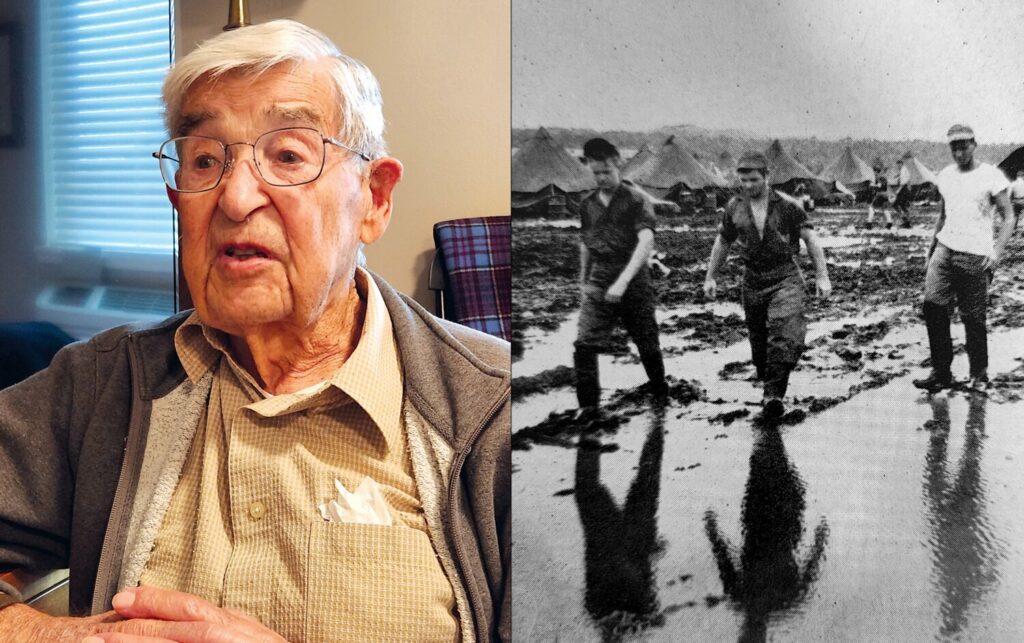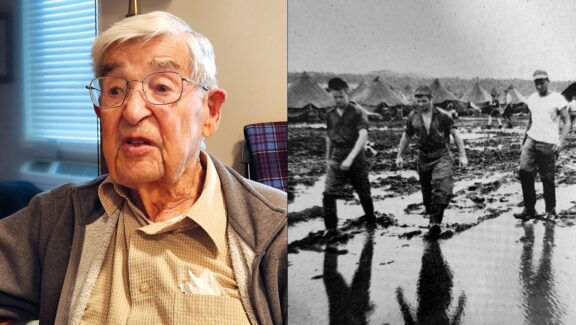Overwhelmingly our team members tell us their favorite thing about their job is the residents and making a difference in their lives. It’s all part of our mission of “Creating a Village That Feels Like Family”.
In the news...
 Bette Stanzel, an Auburn, Washington, native, produces tokens of warmth for those in need half a world away. Photo credit: MENAUM[/caption]
The bright pink of little Nairouz’s knit cap bounces with her—an unexpected flash of color against icy puddles as she skips between the drab tents of a refugee camp in Lebanon's Beqaa Valley. Many things are not ideal in her life, but life is better when a little girl's head is warm.
Nairouz’s small blessing began months before and nearly 11,000 kilometers (approx. 6,800 miles) away, where Bette Stanzel and her friend Vickie Kansanback had turned a ball of donated yarn into the little pink cap. Bette and Vickie will never meet little Nairouz. There is not much chance Nairouz will ever visit the United States, where Bette lives at the Village Concepts assisted living center in Auburn, Washington. Nevertheless, their bond is real and personal.
The connection between the two took place through Pastor Rick McEdward, Bette’s son, who serves as president of the Middle East and North Africa Union (MENA) of Seventh-day Adventists. One day, he walked into the union office in Beirut, Lebanon, with two bulging plastic bags.
“I was shocked when he dumped out 100 knitted caps and a dozen or so scarves onto the conference table,” recalls Melanie Wixwat, assistant secretary of MENA. “They were quite a sight—a pile of colors and textures. He announced that his mom and her friends had hand-knitted every one of them and that he thought families in Lebanon needed them.” Pastor McEdward serves in a region of the world where the warmth, even from a small knit cap, is appreciated.
With the devastating economic environment of Lebanon, where three-quarters of the population live under the poverty level, thousands of refugees add to the need, and recent conflict has caused internal displacement, colorful winter caps and scarves are not a fashion statement; they are a necessity that Bette’s pastime is meeting.
Bette, Pastor McEdward’s 85-year-old mother, has always had abundant energy for volunteering. She has rocked babies in the local hospital nursery, helped in a hospital gift shop, been a library volunteer, driven seniors to medical appointments, and provided scores of caps for infants at the Pediatric Intensive Care Center in her community, all with the joy of being able to help others. However, the international reach of knit caps for Lebanon launched her on a project that has taken her service to the other side of the world.
Melanie, who distributed many of Pastor McEdward's first delivery personally, shares, “We can always find families who will appreciate Bette’s caps; there are too many who need everything, and a little warmth and color is like delivering flowers to them.” In addition to her care group’s family list, scores of caps and scarves have been delivered to a village in the poorest mountainous region of Lebanon, a refugee camp in Lebanon’s Beqaa Valley, and families in the community around the MENA office. Some even made their way to the Syrian camps affected by the February 6, 2023, earthquake, and this winter, some will even reach displaced families coming from the villages on Lebanon’s southern border.
The knitting operation that is blessing so many is based in the sunny commons room of the residential center in Auburn, where a handful of cheerful senior citizens chat and knit. Bette and her friends haven’t always known from where the yarn will come, but their project has benefitted from discarded skeins, close-out sales, and donations. They’ve knitted whatever God has provided.
Bette is convinced the blessing is not just for Nairouz and her world, though. “Knitting keeps our hands busy. It provides something really useful for us to do. I feel lots of joy knowing we are making a difference to people who need so much.” Their mission has also been their blessing.
Of course, a knit cap doesn’t fill all of Nairouz’s needs, but the knitting group at Village Concepts trusts they are sending care messages that mean even more than do the knit caps they are making. The distance between a senior in Washington and a little girl in Lebanon is not too great for God’s love to span to give hope to a young person facing a harsh, cold world.
* Looming is a process where loops of yarn are slipped one at a time on spokes of a frame, producing a knitted cap or scarf."
["post_title"]=>
string(84) "Knitting Project in Pacific Northwest Serves Families Confronting Lebanon’s Winter"
["post_excerpt"]=>
string(0) ""
["post_status"]=>
string(7) "publish"
["comment_status"]=>
string(6) "closed"
["ping_status"]=>
string(6) "closed"
["post_password"]=>
string(0) ""
["post_name"]=>
string(81) "knitting-project-in-pacific-northwest-serves-families-confronting-lebanons-winter"
["to_ping"]=>
string(0) ""
["pinged"]=>
string(0) ""
["post_modified"]=>
string(19) "2024-02-09 18:58:15"
["post_modified_gmt"]=>
string(19) "2024-02-09 18:58:15"
["post_content_filtered"]=>
string(0) ""
["post_parent"]=>
int(0)
["guid"]=>
string(36) "https://villageconcepts.com/?p=14436"
["menu_order"]=>
int(0)
["post_type"]=>
string(4) "post"
["post_mime_type"]=>
string(0) ""
["comment_count"]=>
string(1) "0"
["filter"]=>
string(3) "raw"
}
[1]=>
object(WP_Post)#3189 (24) {
["ID"]=>
int(14371)
["post_author"]=>
string(1) "2"
["post_date"]=>
string(19) "2023-10-12 19:38:41"
["post_date_gmt"]=>
string(19) "2023-10-12 19:38:41"
["post_content"]=>
string(8718) "[caption id="attachment_14372" align="aligncenter" width="1024"]
Bette Stanzel, an Auburn, Washington, native, produces tokens of warmth for those in need half a world away. Photo credit: MENAUM[/caption]
The bright pink of little Nairouz’s knit cap bounces with her—an unexpected flash of color against icy puddles as she skips between the drab tents of a refugee camp in Lebanon's Beqaa Valley. Many things are not ideal in her life, but life is better when a little girl's head is warm.
Nairouz’s small blessing began months before and nearly 11,000 kilometers (approx. 6,800 miles) away, where Bette Stanzel and her friend Vickie Kansanback had turned a ball of donated yarn into the little pink cap. Bette and Vickie will never meet little Nairouz. There is not much chance Nairouz will ever visit the United States, where Bette lives at the Village Concepts assisted living center in Auburn, Washington. Nevertheless, their bond is real and personal.
The connection between the two took place through Pastor Rick McEdward, Bette’s son, who serves as president of the Middle East and North Africa Union (MENA) of Seventh-day Adventists. One day, he walked into the union office in Beirut, Lebanon, with two bulging plastic bags.
“I was shocked when he dumped out 100 knitted caps and a dozen or so scarves onto the conference table,” recalls Melanie Wixwat, assistant secretary of MENA. “They were quite a sight—a pile of colors and textures. He announced that his mom and her friends had hand-knitted every one of them and that he thought families in Lebanon needed them.” Pastor McEdward serves in a region of the world where the warmth, even from a small knit cap, is appreciated.
With the devastating economic environment of Lebanon, where three-quarters of the population live under the poverty level, thousands of refugees add to the need, and recent conflict has caused internal displacement, colorful winter caps and scarves are not a fashion statement; they are a necessity that Bette’s pastime is meeting.
Bette, Pastor McEdward’s 85-year-old mother, has always had abundant energy for volunteering. She has rocked babies in the local hospital nursery, helped in a hospital gift shop, been a library volunteer, driven seniors to medical appointments, and provided scores of caps for infants at the Pediatric Intensive Care Center in her community, all with the joy of being able to help others. However, the international reach of knit caps for Lebanon launched her on a project that has taken her service to the other side of the world.
Melanie, who distributed many of Pastor McEdward's first delivery personally, shares, “We can always find families who will appreciate Bette’s caps; there are too many who need everything, and a little warmth and color is like delivering flowers to them.” In addition to her care group’s family list, scores of caps and scarves have been delivered to a village in the poorest mountainous region of Lebanon, a refugee camp in Lebanon’s Beqaa Valley, and families in the community around the MENA office. Some even made their way to the Syrian camps affected by the February 6, 2023, earthquake, and this winter, some will even reach displaced families coming from the villages on Lebanon’s southern border.
The knitting operation that is blessing so many is based in the sunny commons room of the residential center in Auburn, where a handful of cheerful senior citizens chat and knit. Bette and her friends haven’t always known from where the yarn will come, but their project has benefitted from discarded skeins, close-out sales, and donations. They’ve knitted whatever God has provided.
Bette is convinced the blessing is not just for Nairouz and her world, though. “Knitting keeps our hands busy. It provides something really useful for us to do. I feel lots of joy knowing we are making a difference to people who need so much.” Their mission has also been their blessing.
Of course, a knit cap doesn’t fill all of Nairouz’s needs, but the knitting group at Village Concepts trusts they are sending care messages that mean even more than do the knit caps they are making. The distance between a senior in Washington and a little girl in Lebanon is not too great for God’s love to span to give hope to a young person facing a harsh, cold world.
* Looming is a process where loops of yarn are slipped one at a time on spokes of a frame, producing a knitted cap or scarf."
["post_title"]=>
string(84) "Knitting Project in Pacific Northwest Serves Families Confronting Lebanon’s Winter"
["post_excerpt"]=>
string(0) ""
["post_status"]=>
string(7) "publish"
["comment_status"]=>
string(6) "closed"
["ping_status"]=>
string(6) "closed"
["post_password"]=>
string(0) ""
["post_name"]=>
string(81) "knitting-project-in-pacific-northwest-serves-families-confronting-lebanons-winter"
["to_ping"]=>
string(0) ""
["pinged"]=>
string(0) ""
["post_modified"]=>
string(19) "2024-02-09 18:58:15"
["post_modified_gmt"]=>
string(19) "2024-02-09 18:58:15"
["post_content_filtered"]=>
string(0) ""
["post_parent"]=>
int(0)
["guid"]=>
string(36) "https://villageconcepts.com/?p=14436"
["menu_order"]=>
int(0)
["post_type"]=>
string(4) "post"
["post_mime_type"]=>
string(0) ""
["comment_count"]=>
string(1) "0"
["filter"]=>
string(3) "raw"
}
[1]=>
object(WP_Post)#3189 (24) {
["ID"]=>
int(14371)
["post_author"]=>
string(1) "2"
["post_date"]=>
string(19) "2023-10-12 19:38:41"
["post_date_gmt"]=>
string(19) "2023-10-12 19:38:41"
["post_content"]=>
string(8718) "[caption id="attachment_14372" align="aligncenter" width="1024"]

When Japanese bombers attacked U.S. Navy ships at Pearl Harbor on Dec. 7, 1941, Clarence Piper was a high school sophomore visiting his uncle in the hills of Oregon and read about the attack in the newspaper.
That sneak attack on the naval base at Hawaii, which killed 2,403 people and destroyed eight battleships and 11 other vessels, changed the lives of Piper and millions of other young men in the United States who served in the military to defeat the Axis powers of Germany, Japan and Italy.
“Everyone was involved in World War II,” said Piper, 98, who moved to Woodland Village in Chehalis a few years ago after living two decades in Tenino. “The country was just completely unified, and we all expected to serve one way or another.”
He didn’t enlist because he had no idea what he could do. But Uncle Sam sent a draft notice ordering him to join the military after graduating from Sumner High School in June 1943. When he reported, the Navy needed workers for its naval construction battalions, known as Seabees.
My thoughts flew immediately to John Wayne’s portrayal of civilian contractor “Wedge” Donovan in the 1944 film, The Fighting Seabees, but when I mentioned it, Piper chuckled, describing it as “a total exaggeration.”
“We weren’t much in combat,” he said of his time on Tinian, a small island about 50 miles north of Guam and 5 miles southwest of Saipan where he arrived in the fall of 1944. “I mean, there were a few spots.”
He opened his copy of The 135th Review USNCB, where three men killed on the Marianas island of Tinian were memorialized on the first page of the book commemorating the work of the 135th Construction Battalion.
One night, Piper’s friend, Kenneth Ross, an excellent marksman, stood guard on the perimeter when Japanese tried to sneak into camp. Ross shot and wounded a man, who then pulled out a grenade, held it to his chest, and blew himself up rather than risk being taken prisoner. Piper said his friend had been plagued by guilt and remorse after shooting the soldier and watching him die. Then, on Nov. 7, 1944, Ross, a religiously devout man, died in an accident while cleaning his gun.
“The Marines had done a good job of clearing the island, but there were still holdouts,” Piper said. “You are kind of told to stay on base.”
But on March 18, 1945, three men ventured outside looking for souvenirs and ran into a Japanese unit hiding in a cave. The enemy killed two men — Homer Cameron and Charles Schroeder — while the third escaped to report the losses.
As a laborer in D Platoon, Piper worked with experienced equipment operators on construction crews on Tinian. He erected Quonset huts and served as what was called a “wagon driller.” They used pneumatic air drillers to dig 4-foot-deep holes that they stuffed with dynamite to blast the coral and make way for the runway. They stripped dirt from the coral to build the runway for B-29 pilots. At 18, he didn’t know anything and simply followed orders, he said.
“You could plan on doing kitchen duty about once a month for a week,” he said.
He worked six days a week with Sundays off. They ate a lot of spam, fricassee chicken they called SOS, and powdered eggs, and received an allotment of two beers a month.
Piper, who was born in February 1925, grew up in the Puyallup Valley, the youngest of Francis “Frank” and Stella (Sausser) Piper’s seven children. His father worked as a logger, and his mother tended the children, a big garden and a few cows, chickens and pigs. The family also raised raspberries on their five acres. His mother canned a lot of meat, fruit, and vegetables.
“It’s quite a nice place to grow up,” he said. “It was right in the heart of the Depression, and we were as poor as it can get.”
After spending his first eight grades in a two-room school in McMillin in Pierce County, with eight students in his class, he studied at Sumner High School. He played basketball and enjoyed Christmas plays and singing programs.
In high school, Piper saved money to buy his first car, a 1929 Model A, but couldn’t travel far on his ration of four gallons of gas a month.
“We could drive it to school about three times,” he said.
A farmer friend a year younger than him had more gas ration stamps, so they could drive farther together, even once traveling to Eastern Washington. “He had to supply gasoline for the rest of us,” Piper said.
After he was drafted, Piper was sent to Camp Perry near historic Williamsburg, Virginia, for boot camp, where they did a lot of calisthenics, obstacle courses and marching to improve their physical condition. Assigned to a unit, he spent time in amphibious training at Newport naval base near Providence, Rhode Island, and then in Gulfport, Mississippi, where they did construction work for the Army. He traveled home by train for Christmas leave before sailing on May 18, 1944, aboard a converted French passenger liner. They stopped in Hawaii, where the construction battalion spent two months at Pearl Harbor building barracks. As a Seabee who drove nails and sawed boards, he didn’t expect to see much combat.
When they sailed the Pacific Ocean, Piper said, their converted passenger liner with its huge diesel engine traveled at more than twice the speed of the convoy’s Liberty ships, so periodically it pulled to the side and maintained a zigzag pattern to avoid Japanese submarines while revving the motor until the rest of the ships caught up.
On Oct. 24, 1944, the 135th Naval Construction Battalion arrived at Tinian, where average annual rainfall was 75 inches, twice the annual precipitation of the Puyallup Valley.
“It was a muddy mess really,” Piper said.
Tinian, an island at most 10 miles long and less than 40 square miles altogether, was formed by a coral reef exposed as the ocean receded rather than by volcanic eruptions like many islands.
“It was flat,” Piper said, “so it was ideal for building a large airbase. The north end was very flat and didn’t have as much vegetation on it. That’s where the airfield was started.”
From Tinian, B-29 pilots to launch bombing raids on Tokyo, Japan, about 1,500 miles away, which took 12 hours round-trip. Piper recalled before he joined the military when, on Feb. 18, 1943, the prototype B-29 bomber crashed into the Frye Meat Packing Plant south of Seattle, exploded, and killed eight men on the plane and 20 workers in the building. That happened on his 18th birthday and kind of set back the program, he said, but by the time he served on Tinian, B-29s there flew round-the-clock bombing raids to Japan.
" ["post_title"]=> string(72) "Julie McDonald: Navy Seabee recalls work on island of Tinian during WWII" ["post_excerpt"]=> string(0) "" ["post_status"]=> string(7) "publish" ["comment_status"]=> string(6) "closed" ["ping_status"]=> string(6) "closed" ["post_password"]=> string(0) "" ["post_name"]=> string(71) "julie-mcdonald-navy-seabee-recalls-work-on-island-of-tinian-during-wwii" ["to_ping"]=> string(0) "" ["pinged"]=> string(0) "" ["post_modified"]=> string(19) "2023-10-12 19:39:05" ["post_modified_gmt"]=> string(19) "2023-10-12 19:39:05" ["post_content_filtered"]=> string(0) "" ["post_parent"]=> int(0) ["guid"]=> string(44) "https://villageconcept.wpengine.com/?p=14371" ["menu_order"]=> int(0) ["post_type"]=> string(4) "post" ["post_mime_type"]=> string(0) "" ["comment_count"]=> string(1) "0" ["filter"]=> string(3) "raw" } [2]=> object(WP_Post)#3190 (24) { ["ID"]=> int(14272) ["post_author"]=> string(1) "2" ["post_date"]=> string(19) "2023-04-26 21:12:41" ["post_date_gmt"]=> string(19) "2023-04-26 21:12:41" ["post_content"]=> string(2468) "[caption id="attachment_14273" align="aligncenter" width="1314"] From the 2023 issue of The Faces of Skagit County[/caption]
Village Concepts of Sedro-Woolley: Country Meadow Village brings retirement to life every day for their residents. They offer a wide variety of events and activities to promote lifelong learning and enjoyment.
"We have an amazing group of employees dedicated to our residents," said David Bricka, program director. "Many have been with Country Meadow Village for more than 10 years."
The retirement community offers assisted and independent living for everyone in a peaceful, countryside setting.
Village Concepts was started by Bill Brown more than 50 years ago. The thirteen communities located in Washington are still managed by the Brown family.
Under the Brown family's ownership, Country Meadow Village opened in 1993. As part of the three-generation family-owned business, Country Meadow Village treats their residents like family.
"We have no delineation between our assisted and independent residents," said David. "Everyone can gather to celebrate all our events and activities together."
David has been Country Meadow Village's program director for over 14 years. He always makes sure the community, which is everyonoe's home, is festively decorated for all seasons of the year. Last Christmas, more than 17,000 lights glowed inside and out. For Independence Day, the place is festooned with flags, bandanas and a custom-created "Welcome, Loggerodeo" banner over the entrance portico to celebrate Sedro-Woolley's oldest continuous 4th of July celebration in Washington. There are so many other fun activities including the patriotic door-decorating contest for all residents. Sedro-Woolley's mayor serves as guest judge for the event. Winners are announced at the annual root beer float social held in the courtyard.
Country Meadow Village is hosting the multi-chamber after-hours event in September 2023 to celebrate their 30th anniversary.
It's obvious that David and all of the staff work hard to ensure all residents feel like they're truly part of the Country Meadow Village family.
One thing many Skagit Valley residents don't realize is that Country Meadow Village houses the satellite branch of the Sedro-Woolley Museum."
["post_title"]=>
string(29) "The Face of Retirement Living"
["post_excerpt"]=>
string(0) ""
["post_status"]=>
string(7) "publish"
["comment_status"]=>
string(6) "closed"
["ping_status"]=>
string(6) "closed"
["post_password"]=>
string(0) ""
["post_name"]=>
string(29) "the-face-of-retirement-living"
["to_ping"]=>
string(0) ""
["pinged"]=>
string(0) ""
["post_modified"]=>
string(19) "2023-04-26 21:14:22"
["post_modified_gmt"]=>
string(19) "2023-04-26 21:14:22"
["post_content_filtered"]=>
string(0) ""
["post_parent"]=>
int(0)
["guid"]=>
string(44) "https://villageconcept.wpengine.com/?p=14272"
["menu_order"]=>
int(0)
["post_type"]=>
string(4) "post"
["post_mime_type"]=>
string(0) ""
["comment_count"]=>
string(1) "0"
["filter"]=>
string(3) "raw"
}
}
["post_count"]=>
int(3)
["current_post"]=>
int(-1)
["before_loop"]=>
bool(true)
["in_the_loop"]=>
bool(false)
["post"]=>
object(WP_Post)#3187 (24) {
["ID"]=>
int(14436)
["post_author"]=>
string(1) "2"
["post_date"]=>
string(19) "2024-02-09 18:56:47"
["post_date_gmt"]=>
string(19) "2024-02-09 18:56:47"
["post_content"]=>
string(4696) "[caption id="attachment_14437" align="aligncenter" width="2048"]
From the 2023 issue of The Faces of Skagit County[/caption]
Village Concepts of Sedro-Woolley: Country Meadow Village brings retirement to life every day for their residents. They offer a wide variety of events and activities to promote lifelong learning and enjoyment.
"We have an amazing group of employees dedicated to our residents," said David Bricka, program director. "Many have been with Country Meadow Village for more than 10 years."
The retirement community offers assisted and independent living for everyone in a peaceful, countryside setting.
Village Concepts was started by Bill Brown more than 50 years ago. The thirteen communities located in Washington are still managed by the Brown family.
Under the Brown family's ownership, Country Meadow Village opened in 1993. As part of the three-generation family-owned business, Country Meadow Village treats their residents like family.
"We have no delineation between our assisted and independent residents," said David. "Everyone can gather to celebrate all our events and activities together."
David has been Country Meadow Village's program director for over 14 years. He always makes sure the community, which is everyonoe's home, is festively decorated for all seasons of the year. Last Christmas, more than 17,000 lights glowed inside and out. For Independence Day, the place is festooned with flags, bandanas and a custom-created "Welcome, Loggerodeo" banner over the entrance portico to celebrate Sedro-Woolley's oldest continuous 4th of July celebration in Washington. There are so many other fun activities including the patriotic door-decorating contest for all residents. Sedro-Woolley's mayor serves as guest judge for the event. Winners are announced at the annual root beer float social held in the courtyard.
Country Meadow Village is hosting the multi-chamber after-hours event in September 2023 to celebrate their 30th anniversary.
It's obvious that David and all of the staff work hard to ensure all residents feel like they're truly part of the Country Meadow Village family.
One thing many Skagit Valley residents don't realize is that Country Meadow Village houses the satellite branch of the Sedro-Woolley Museum."
["post_title"]=>
string(29) "The Face of Retirement Living"
["post_excerpt"]=>
string(0) ""
["post_status"]=>
string(7) "publish"
["comment_status"]=>
string(6) "closed"
["ping_status"]=>
string(6) "closed"
["post_password"]=>
string(0) ""
["post_name"]=>
string(29) "the-face-of-retirement-living"
["to_ping"]=>
string(0) ""
["pinged"]=>
string(0) ""
["post_modified"]=>
string(19) "2023-04-26 21:14:22"
["post_modified_gmt"]=>
string(19) "2023-04-26 21:14:22"
["post_content_filtered"]=>
string(0) ""
["post_parent"]=>
int(0)
["guid"]=>
string(44) "https://villageconcept.wpengine.com/?p=14272"
["menu_order"]=>
int(0)
["post_type"]=>
string(4) "post"
["post_mime_type"]=>
string(0) ""
["comment_count"]=>
string(1) "0"
["filter"]=>
string(3) "raw"
}
}
["post_count"]=>
int(3)
["current_post"]=>
int(-1)
["before_loop"]=>
bool(true)
["in_the_loop"]=>
bool(false)
["post"]=>
object(WP_Post)#3187 (24) {
["ID"]=>
int(14436)
["post_author"]=>
string(1) "2"
["post_date"]=>
string(19) "2024-02-09 18:56:47"
["post_date_gmt"]=>
string(19) "2024-02-09 18:56:47"
["post_content"]=>
string(4696) "[caption id="attachment_14437" align="aligncenter" width="2048"]



Knitting Project in Pacific Northwest Serves Families Confronting Lebanon’s Winter
The bright pink of little Nairouz’s knit cap bounces with her—an unexpected flash of color against icy puddles as she skips between the drab tents of a refugee camp in Lebanon’s Beqaa Valley. Many things are not ideal in her life, but life is better when a little girl’s head is warm. Nairouz’s small blessing…


Julie McDonald: Navy Seabee recalls work on island of Tinian during WWII
When Japanese bombers attacked U.S. Navy ships at Pearl Harbor on Dec. 7, 1941, Clarence Piper was a high school sophomore visiting his uncle in the hills of Oregon and read about the attack in the newspaper. That sneak attack on the naval base at Hawaii, which killed 2,403 people and destroyed eight battleships and…

The Face of Retirement Living
Village Concepts of Sedro-Woolley: Country Meadow Village brings retirement to life every day for their residents. They offer a wide variety of events and activities to promote lifelong learning and enjoyment. “We have an amazing group of employees dedicated to our residents,” said David Bricka, program director. “Many have been with Country Meadow Village for…
